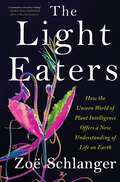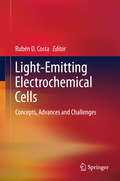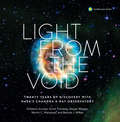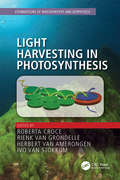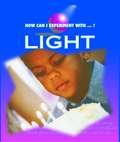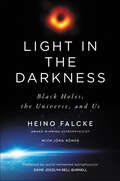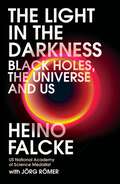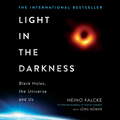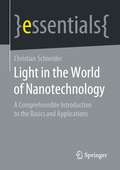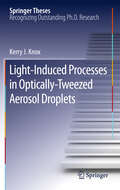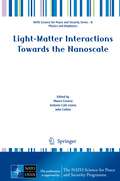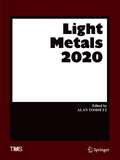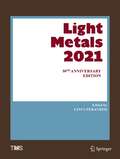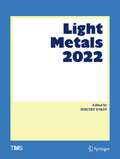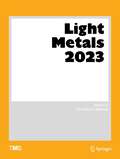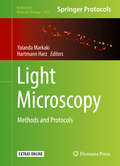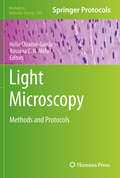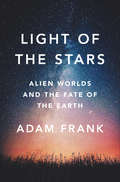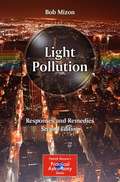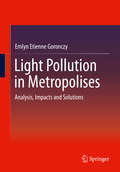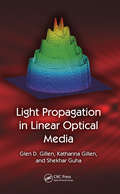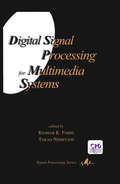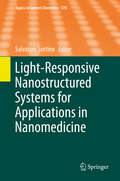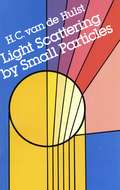- Table View
- List View
The Light Eaters: How the Unseen World of Plant Intelligence Offers a New Understanding of Life on Earth
by Zoë Schlanger“A masterpiece of science writing.” –Robin Wall Kimmerer, author of Braiding Sweetgrass“Mesmerizing, world-expanding, and achingly beautiful.” –Ed Yong, author of An Immense World“Rich, vital, and full of surprises. Read it!” –Elizabeth Kolbert, author of Under a White Sky and The Sixth Extinction “A brilliant must-read. This book shook and changed me.” –David George Haskell, author of Sounds Wild and Broken, The Songs of Trees, and The Forest UnseenAward-winning Atlantic staff writer Zoë Schlanger delivers a groundbreaking work of popular science that probes the hidden world of the plant kingdom and reveals the astonishing capabilities of the green life all around us.It takes tremendous biological creativity to be a plant. To survive and thrive while rooted in a single spot, plants have adapted ingenious methods of survival. In recent years, scientists have learned about their ability to communicate, recognize their kin and behave socially, hear sounds, morph their bodies to blend into their surroundings, store useful memories that inform their life cycle, and trick animals into behaving to their benefit, to name just a few remarkable talents.The Light Eaters is a deep immersion into the drama of green life and the complexity of this wild and awe-inspiring world that challenges our very understanding of agency, consciousness, and intelligence. In looking closely, we see that plants, rather than imitate human intelligence, have perhaps formed a parallel system. What is intelligent life if not a vine that grows leaves to blend into the shrub on which it climbs, a flower that shapes its bloom to fit exactly the beak of its pollinator, a pea seedling that can hear water flowing and make its way toward it? Zoë Schlanger takes us across the globe, digging into her own memories and into the soil with the scientists who have spent their waking days studying these amazing entities up close.What can we learn about life on Earth from the living things that thrive, adapt, consume, and accommodate simultaneously? More important, what do we owe these life forms once we come to understand their rich and varied abilities? Examining the latest epiphanies in botanical research, Schlanger spotlights the intellectual struggles among the researchers conceiving a wholly new view of their subject, offering a glimpse of a field in turmoil as plant scientists debate the tenets of ongoing discoveries and how they influence our understanding of what a plant is.We need plants to survive. But what do they need us for—if at all? An eye-opening and informative look at the ecosystem we live in, this book challenges us to rethink the role of plants—and our own place—in the natural world.
Light-Emitting Electrochemical Cells
by Rubén D. CostaThis book presents the recent achievements towards the next generation of Light-emitting electrochemical cells (LEC). Its first part focus on the definition, history and mechanism of LEC, going then to concepts and challenges and, finally, giving the reader examples of current application of new electroluminescent materials. The chapters are written by different international groups working on LEC.
Light from the Void: Twenty Years of Discovery with NASA's Chandra X-ray Observatory
by Kimberly K. Arcand Megan Watzke Grant Tremblay Martin C. Weisskoph Belinda J. WilkesA lavish coffee-table book featuring spectacular images from the Chandra X-Ray Observatory, the most powerful X-Ray telescope ever builtTake a journey through the cosmos with Light from the Void, a stunning collection of photographs from the Chandra X-Ray Observatory's two decades of operation. The book showcases rarely-seen celestial phenomena such as black holes, planetary nebulae, galaxy clusters, gravitational waves, stellar birth and death, and more. Accompanying these images of incredible natural phenomena are captions explaining how they occur. The images start close to home and move outward: beginning with images of the Chandra launch, then moving into the solar system, through the nearby universe, and finally to the most distant galaxies Chandra has observed, the book brings readers on a far-out visual voyage.
Light Harvesting in Photosynthesis (Foundations of Biochemistry and Biophysics)
by Rienk Van Grondelle Roberta Croce Herbert Van Amerongen Ivo Van StokkumThis landmark collective work introduces the physical, chemical, and biological principles underlying photosynthesis: light absorption, excitation energy transfer, and charge separation. It begins with an introduction to properties of various pigments, and the pigment proteins in plant, algae, and bacterial systems. It addresses the underlying physics of light harvesting and key spectroscopic methods, including data analysis. It discusses assembly of the natural system, its energy transfer properties, and regulatory mechanisms. It also addresses light-harvesting in artificial systems and the impact of photosynthesis on our environment. The chapter authors are amongst the field’s world recognized experts. <P><P> Chapters are divided into five main parts, the first focused on pigments, their properties and biosynthesis, and the second section looking at photosynthetic proteins, including light harvesting in higher plants, algae, cyanobacteria, and green bacteria. The third part turns to energy transfer and electron transport, discussing modeling approaches, quantum aspects, photoinduced electron transfer, and redox potential modulation, followed by a section on experimental spectroscopy in light harvesting research. The concluding final section includes chapters on artificial photosynthesis, with topics such as use of cyanobacteria and algae for sustainable energy production. <P><P> Robert Croce is Head of the Biophysics Group and full professor in biophysics of photosynthesis/energy at Vrije Universiteit, Amsterdam. Rienk van Grondelle is full professor at Vrije Universiteit, Amsterdam. Herbert van Amerongen is full professor of biophysics in the Department of Agrotechnology and Food Sciences at Wageningen University, where he is also director of the MicroSpectroscopy Research Facility. Ivo van Stokkum is associate professor in the Department of Physics and Astronomy, Faculty of Sciences, at Vrije Universiteit, Amsterdam.
Light (How Can I Experiment With...?)
by Cindy Devine DaltonThe "How Can I Experiment With...?" answers many interesting questions. In this book, we consider light. Do you know what would happen if you could fly in a spacecraft at the speed of light? Other books in this series are available in this library. What is light made of? Why does it hurt your ears when someone scratches a chalkboard? Why do you always fall down--and not up? This series takes you on a journey from the inside of a tiny atom to the outer reaches of space. Try out the hands-on experiments inside so you can see for yourself how gravity, sound, simple machines, and more work. If you're learning about physical sciences in school, these books are a great way to go in-depth, or to get ahead!
Light in the Darkness: Black Holes, the Universe, and Us
by Heino Falcke Jörg RömerThe International BestsellerOn April 10, 2019, award-winning astrophysicist Heino Falcke presented the first image ever captured of a black hole at an international press conference—a turning point in astronomy that Science magazine called the scientific breakthrough of the year. That photo was captured with the unthinkable commitment of an intercontinental team of astronomers who transformed the world into a global telescope. While this image achieved Falcke’s goal in making a black hole “visible” for the first time, he recognizes that the photo itself asks more questions for humanity than it answers. Light in the Darkness takes us on Falcke’s extraordinary journey to the darkest corners of the universe. From the first humans looking up at the night sky to modern astrophysics, from the study of black holes to the still-unsolved mysteries of the universe, Falcke asks, in even the greatest triumphs of science, is there room for doubts, faith, and a God? A plea for curiosity and humility, Light in the Darkness sees one of the great minds shaping the world today as he ponders the big, pressing questions that present themselves when we look up at the stars.
Light in the Darkness: Black Holes, The Universe and Us
by Professor Heino Falcke Jörg RömerAs featured in THE EDGE OF ALL WE KNOW - the new Netflix documentary about Black HolesFor readers of Stephen Hawking, a fascinating account of the universe from the perspective of world-leading astrophysicist Heino Falcke, who took the first ever picture of a black hole.10th April 2019: a global sensation. Heino Falcke, a man "working at the boundaries of his discipline and therefore at the limits of the universe" had used a network of telescopes spanning the entire planet to take the first picture of a black hole.Light in the Darkness examines how mankind has always looked to the skies, mapping the journey from millennia ago when we turned our gaze to the heavens, to modern astrophysics. Heino Falcke and Jorg Romer entertainingly and compellingly chart the breakthrough research of Falcke's team, an unprecedented global community of international colleagues developing a telescope complex enough to look directly into a black hole - a hole where light vanishes, and time stops.What does this development mean? Is this the beginning of a new physics? What can we learn from this about God, the world, and ourselves? For Falcke, astrophysics and metaphysics, science and faith, do not exclude one another. Black Hole is both a plea for curiosity and humility; it's interested in both what we know, and the mysteries that remain unsolved.
Light in the Darkness: Black Holes, The Universe and Us
by Professor Heino Falcke Jörg RömerAs featured in THE EDGE OF ALL WE KNOW - the new Netflix documentary about Black HolesFor readers of Stephen Hawking, a fascinating account of the universe from the perspective of world-leading astrophysicist Heino Falcke, who took the first ever picture of a black hole.10th April 2019: a global sensation. Heino Falcke, a man "working at the boundaries of his discipline and therefore at the limits of the universe" had used a network of telescopes spanning the entire planet to take the first picture of a black hole.Light in the Darkness examines how mankind has always looked to the skies, mapping the journey from millennia ago when we turned our gaze to the heavens, to modern astrophysics. Heino Falcke and Jorg Romer entertainingly and compellingly chart the breakthrough research of Falcke's team, an unprecedented global community of international colleagues developing a telescope complex enough to look directly into a black hole - a hole where light vanishes, and time stops.What does this development mean? Is this the beginning of a new physics? What can we learn from this about God, the world, and ourselves? For Falcke, astrophysics and metaphysics, science and faith, do not exclude one another. Black Hole is both a plea for curiosity and humility; it's interested in both what we know, and the mysteries that remain unsolved.(P)2021 Headline Publishing Group Limited
Light in the World of Nanotechnology: A Comprehensible Introduction to the Basics and Applications (essentials)
by Christian SchneiderThis essential gives an overview of the physical principles underlying nanotechnology, which today make it possible to use microscopic effects technologically. Methods are presented which allow the production of nanostructures with highest precision. In the last chapter the author gives an overview of exciting technological applications, starting with the use of nanotechnology-based effects in church glass windows to solar cells and CCD chips. This book is a translation of the original German 1st edition Licht in der Welt der Nanotechnologie by Christian Schneider, published by Springer Fachmedien Wiesbaden GmbH, part of Springer Nature in 2016. The translation was done with the help of artificial intelligence (machine translation by the service DeepL.com). A subsequent human revision was done primarily in terms of content, so that the book will read stylistically differently from a conventional translation. Springer Nature works continuously to further the development of tools for the production of books and on the related technologies to support the authors.
Light-Induced Processes in Optically-Tweezed Aerosol Droplets
by Kerry J. KnoxAerosols play a critical role in a broad range of scientific disciplines, such as atmospheric chemistry and physics, combustion science, drug delivery and human health. This thesis explores the fundamentals of a new technique for capturing single or multiple particles using light, and for characterising these particles by Raman or fluorescence spectroscopy. The outcome of this research represents a significant development in optical manipulation techniques, specifically in optical tweezing. These findings can be applied to studies of the mass accommodation of gas-phase water molecules adsorbing onto a water surface. Not only is this a fundamental process of interest to physical chemists, but it is important for understanding the role of aerosol particles in the atmosphere, including their ability to become cloud droplets. This new strategy for investigating aerosol dynamics is fundamental in helping us understand the indirect effect of aerosols on the climate.
Light-Matter Interactions Towards the Nanoscale (NATO Science for Peace and Security Series B: Physics and Biophysics)
by Maura Cesaria Antonio Calà Lesina John CollinsThe investigation of light-matter interactions in materials, especially those on the nanoscale, represents perhaps the most promising avenue for scientific progress in the fields of photonics and plasmonics. This book examines a variety of topics, starting from fundamental principles, leading to the current state of the art research. For example, this volume includes a chapter on the sensing of biological molecules with optical resonators (microspheres) combined with plasmonic systems, where the response this system are described in a fundamental and elegant manner using coupled mode theory. Symmetry plays a major role in the book. One chapter on time reversal symmetry in electromagnetic theory describes how to control the properties of light (e.g. scattering and directionality of the flow of light) in materials with certain topological invariants. Another chapter where symmetry is prominent reformulates, using a gentle and pedagogical approach, Maxwell’s Equations into a new set of fields that reveal a “handedness” symmetry in electromagnetic theory, which can be applied to photonic systems in, for example, the sensing of chiral molecules and understanding the conditions for zero reflection. Also, for students and researchers starting in the field of nanoplasmonics, the book includes a tutorial on the finite element time domain simulation of nanoplasmonic systems. Other topics include photonic systems for quantum computing, nanoplasmonics, and optical properties of nano and bulk materials. The authors take a pedagogical approach to their topic, making the book an excellent reference for graduate students and scientists starting in the fields of photonics or plasmonics.
Light Metals 2020 (The Minerals, Metals & Materials Series)
by Alan TomsettThe Light Metals symposia at the TMS Annual Meeting & Exhibition present the most recent developments, discoveries, and practices in primary aluminum science and technology. The annual Light Metals volume has become the definitive reference in the field of aluminum production and related light metal technologies. The 2020 collection includes papers from the following symposia: • Alumina and Bauxite• Aluminum Alloys, Processing and Characterization• Aluminum Reduction Technology• Cast Shop Technology• Cast Shop Technology: Recycling and Sustainability Joint Session• Electrode Technology for Aluminum Production
Light Metals 2021: 50th Anniversary Edition (The Minerals, Metals & Materials Series)
by Linus PeranderThe Light Metals symposia at the TMS Annual Meeting & Exhibition present the most recent developments, discoveries, and practices in primary aluminum science and technology. The annual Light Metals volume has become the definitive reference in the field of aluminum production and related light metal technologies. The 2021 collection includes contributions from the following symposia: · Alumina and Bauxite · Aluminum Alloys, Processing, and Characterization · Aluminum Reduction Technology · Aluminum Reduction Technology Across the Decades: An LMD Symposium Honoring Alton T. Tabereaux, Halvor Kvande and Harald A. Øye · Cast Shop Technology · Electrode Technology for Aluminum Production
Light Metals 2022 (The Minerals, Metals & Materials Series)
by Dmitry EskinThe Light Metals symposia at the TMS Annual Meeting & Exhibition present the most recent developments, discoveries, and practices in primary aluminum science and technology. The annual Light Metals volume has become the definitive reference in the field of aluminum production and related light metal technologies. The 2022 collection includes contributions from the following symposia: • Alumina and Bauxite • Aluminum Alloys, Processing and Characterization • Aluminum Reduction Technology • Aluminum Reduction Technology Joint Session with REWAS: Decarbonizing the Metals Industry • Cast Shop Technology • Electrode Technology for Aluminum Production • Primary Aluminum Industry—Energy and Emission Reductions: An LMD Symposium in Honor of Halvor Kvande • Recycling and Sustainability in Cast Shop Technology: Joint Session with REWAS 2022
Light Metals 2023 (The Minerals, Metals & Materials Series)
by Stephan BroekThe Light Metals symposia at the TMS Annual Meeting & Exhibition present the most recent developments, discoveries, and practices in primary aluminum science and technology. The annual Light Metals volume has become the definitive reference in the field of aluminum production and related light metal technologies. The 2023 collection includes contributions from the following symposia: · 60 Years of Taking Aluminum Smelting Research and Development from New Zealand to the World: An LMD Symposium in Honor of Barry J. Welch · Alumina & Bauxite · Aluminium Industry Emissions Measurement, Reporting & Reduction · Aluminium Waste Management & Utilisation · Aluminum Alloys, Characterization and Processing · Aluminum Reduction Technology · Cast Shop Technology · Electrode Technology for Aluminum Production · Scandium Extraction and Use in Aluminum Alloys
Light Microscopy
by Yolanda Markaki Hartmann HarzThis volume addresses up-to-date light microscopy approaches and toolsets offered for live- or fixed-cell observations. The imaging strategies discussed in this book include confocal laser scanning and spinning disk confocal microscopy, FRET, FRAP, and laser microsurgery experiments. Chapters also describe the use of these imaging methodologies to study properties of a multitude of biomolecular targets in a broad range of model systems ranging from bacteria over tissue to whole animal imaging. Light Microscopy: Methods and Protocols puts special focus on system instrumentation parameters and sophisticated labeling and detection methods. Written in the highly successful Methods in Molecular Biology series format, chapters include introductions to their respective topics, lists of the necessary materials and reagents, step-by-step, readily reproducible laboratory protocols, and tips on troubleshooting and avoiding known pitfalls. Cutting-edge and thorough, Light Microscopy: Methods and Protocols offers the novice user with straightforward strategies to address biological questions, while providing the experienced researcher with the latest applications that can be useful in routine practices. This book also serves as a useful teaching manual in practical courses on light microscopy.
Light Microscopy
by Rossana C. Melo Hélio Chiarini-GarciaOf all scientific instruments, probably none has had more applications in the life sciences than the light microscope. In Light Microscopy: Methods and Protocols, expert researchers explore the basics and the latest advances in microscope instrumentation, sample preparation, and imaging techniques, all of which have been producing fundamental insights into the functions of cells and tissues. Chapters cover a variety of bright field and fluorescence microscopy-based approaches that are central to the study of a range of biological questions, providing information on how to prepare cells and tissues for microscopic investigations, covering detailed staining procedures, and exploring methods to analyze images and interpret the results accurately. Composed in the highly successful Methods in Molecular BiologyTM series format, each chapter contains a brief introduction, step-by-step methods, a list of necessary materials, and a Notes section which shares tips on troubleshooting and avoiding known pitfalls. Comprehensive and current, Light Microscopy: Methods and Protocols is an essential handbook for all researchers who are exploring the intriguing microscopic world of the cell.
Light of the Stars: Alien Worlds And The Fate Of The Earth
by Adam FrankAstrophysicist and NPR commentator on what the latest research on the existence and trajectories of alien civilizations may teach us about our own. Light of the Stars tells the story of humanity’s coming of age as we awaken to the possibilities of life on other worlds and their sudden relevance to our fate on Earth. Astrophysicist Adam Frank traces the question of alien life and intelligence from the ancient Greeks to the leading thinkers of our own time, and shows how we as a civilization can only hope to survive climate change if we recognize what science has recently discovered: that we are just one of ten billion trillion planets in the Universe, and it’s highly likely that many of those planets hosted technologically advanced alien civilizations. What’s more, each of those civilizations must have faced the same challenge of civilization-driven climate change. Written with great clarity and conviction, Light of the Stars builds on the inspiring work of pioneering scientists such as Frank Drake and Carl Sagan, whose work at the dawn of the space age began building the new science of astrobiology; Jack James, the Texas-born engineer who drove NASA’s first planetary missions to success; Vladimir Vernadsky, the Russian geochemist who first envisioned the Earth’s biosphere; and James Lovelock and Lynn Margulis, who invented Gaia theory. Frank recounts the perilous journey NASA undertook across millions of miles of deep space to get its probes to Venus and Mars, yielding our first view of the cosmic laws of planets and climate that changed our understanding of our place in the universe. Thrilling science at the grandest of scales, Light of the Stars explores what may be the largest question of all: What can the likely presence of life on other worlds tell us about our own fate?
Light Pollution: Responses and Remedies (The Patrick Moore Practical Astronomy Series)
by Bob MizonThere have been many developments in the field of light pollution over the last few years, and this second edition of 'Light Pollution - Responses and Remedies' will introduce them in detail. Examples include the appearance of anti-light pollution legislation in various countries, new departures in lighting design, human health implications, and the growing realization among the general public that lighting is not always a good thing. In this title, author Bob Mizon discusses the various ways in which wasted artificial light has damaged the quality of modern life, and suggest solutions. This book is for anyone who has experienced glare, discomfort, or nuisance from poorly directed lights; has wondered why we waste so much money lighting the sky; or anyone who simply wants to see the stars instead of a baleful urban glow. "Light Pollution, 2nd Edition" offers practical and inexpensive solutions to the world-wide problem of wasted artificial light, and emphasizes that light pollution is not just an astronomers' problem, but affects everyone in various ways.
Light Pollution in Metropolises: Analysis, Impacts and Solutions
by Emlyn Etienne GoronczyLight pollution (light smog, light pollution or light emissions) is a fundamental problem in metropolises with effects on flora, fauna and people. Accordingly, the first section of the book discusses the basics of light pollution and its effects on various organisms. The characteristics of light smog in the cities of Hanover, Warsaw, Boston, New York City and Toronto are then analysed and compared. But how can the problem be tackled? Existing measures for the prevention of light pollution are discussed and further novel approaches are shown by comparing the metropolises. The book is aimed primarily at practitioners in this field and helps to identify sources of emissions and identify suitable reduction measures. This book is a translation of the original German edition „Lichtverschmutzung in Metropolen“ by Emlyn Etienne Goronczy, published by Springer Fachmedien Wiesbaden GmbH in 2018. The translation was done with the help of artificial intelligence (machine translation by the service DeepL.com). A subsequent human revision was done primarily in terms of content, so that the book will read stylistically differently from a conventional translation. Springer Nature works continuously to further the development of tools for the production of books and on the related technologies to support the authors.
Light Propagation in Linear Optical Media
by Glen D. Gillen Katharina Gillen Shekhar GuhaLight Propagation in Linear Optical Media describes light propagation in linear media by expanding on diffraction theories beyond what is available in classic optics books. In one volume, this book combines the treatment of light propagation through various media, interfaces, and apertures using scalar and vector diffraction theories. After covering the fundamentals of light and physical optics, the authors discuss light traveling within an anisotropic crystal and present mathematical models for light propagation across planar boundaries between different media. They describe the propagation of Gaussian beams and discuss various diffraction models for the propagation of light. They also explore methods for spatially confining (trapping) cold atoms within localized light-intensity patterns. This book can be used as a technical reference by professional scientists and engineers interested in light propagation and as a supplemental text for upper-level undergraduate or graduate courses in optics.
Light Propagation in Periodic Media: Differential Theory and Design (Optical Science and Engineering #Vol. 81)
by Michel Neviere Evgeny PopovBased on more than 30 years of research on differential theories of gratings, this book describes developments in differential theory for applications in spectroscopy, acoustics, X-ray instrumentation, optical communication, information processing, photolithography, high-power lasers, high-precision engineering, and astronomy. Introducing the Fast Fourier Factorization approach to improve the convergence of a truncated series, the book examines multilayers, stacked gratings, crossed gratings, photonic crystals, and isotropic and anisotropic materials; techniques and examples in grating design; and Maxwell equations in a truncated Fourier space.
Light-Responsive Nanostructured Systems for Applications in Nanomedicine
by Salvatore SortinoThe series Topics in Current Chemistry presents critical reviews of the present and future trends in modern chemical research. The scope of coverage is all areas of chemical science including the interfaces with related disciplines such as biology, medicine and materials science. The goal of each thematic volume is to give the non-specialist reader, whether in academia or industry, a comprehensive insight into an area where new research is emerging which is of interest to a larger scientific audience. Each review within the volume critically surveys one aspect of that topic and places it within the context of the volume as a whole. The most significant developments of the last 5 to 10 years are presented using selected examples to illustrate the principles discussed. The coverage is not intended to be an exhaustive summary of the field or include large quantities of data, but should rather be conceptual, concentrating on the methodological thinking that will allow the non-specialist reader to understand the information presented. Contributions also offer an outlook on potential future developments in the field. Review articles for the individual volumes are invited by the volume editors. Readership: research chemists at universities or in industry, graduate students.
Light Scattering by Ice Crystals
by Liou Kuo-Nan Ping Yang Yoshihide TakanoThis research volume outlines the scientific foundations that are central to our current understanding of light scattering, absorption and polarization processes involving ice crystals. It also demonstrates how data from satellite remote sensing of cirrus clouds can be combined with radiation parameterizations in climate models to estimate the role of these clouds in temperature and precipitation responses to climate change. Providing a balanced treatment of the fundamentals and applications, this book synthesizes the authors' own work, as well as that of other leading researchers in this area. Numerous illustrations are included, including three-dimensional schematics, to provide a concise discussion of the subject and enable easy visualization of the key concepts. This book is intended for active researchers and advanced graduate students in atmospheric science, climatology, and remote sensing, as well as scholars in related fields such as ice microphysics, electromagnetic wave propagation, geometric optics, radiative transfer and cloud-climate interactions.
Light Scattering by Small Particles
by H. C. Hulst"A must for researchers using the techniques of light scattering." - S. C. Snowdon, Journal of the Franklin InstituteThe measurement of light scattering of independent, homogeneous particles has many useful applications in physical chemistry, meteorology and astronomy. There is, however, a sizeable gap between the abstract formulae related to electromagnetic-wave-scattering phenomena, and the computation of reliable figures and curves. Dr. van de Hulst's book enables researchers to bridge that gap. The product of twelve years of work, it is an exhaustive study of light-scattering properties of small, individual particles, and includes a survey of all the relevant literature.Beginning with a broad overview of basic scattering theory, Dr. van de Hulst covers the conservation of energy and momentum; wave propagation in vacuum and in a medium containing scatterers; and polarized light and symmetry relations. The heart of the book is devoted to the rigorous scattering theory for spheres of arbitrary size (Mie theory) and to various modes of approximation such as the Rayleigh-Gaas approximation, the perfect reflection approximation, the geometrical-optics approximation, and others. Methods of computation are given with respect to different kinds of particles, bodies and phenomena: particles small or very large compared to the wavelength, absorbing and nonabsorbing spheres, water drops, circular cylinders, edge phenomena and surface waves, and many others. In the last part, the author covers the use of scattering and extinction experiments as a practical tool, including applications in chemistry, meteorology and astronomy.This book's comprehensive, lucid coverage of the field makes it a valuable source for all those interested in light-scattering theory. It is absolutely essential for researchers needing to employ light-scattering measurements, and its republication will be welcomed especially by those who have found this necessary source difficult to obtain. Over 400 references. 46 tables. 59 graphs. Subject and name indexes. 44 illustrations.
